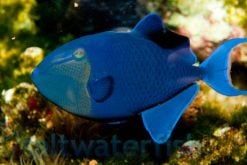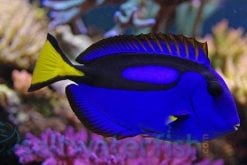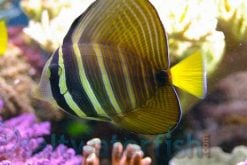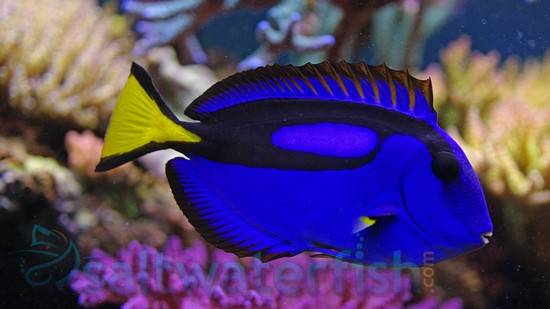-
×
 Niger Trigger, Size 2.25 - 4.25 inches
1 × $29.00
Niger Trigger, Size 2.25 - 4.25 inches
1 × $29.00 -
×
 Blue Hippo Tang, Size 1.25 - 2 inches
1 × $76.99
Blue Hippo Tang, Size 1.25 - 2 inches
1 × $76.99 -
×
 Sailfin Tang - Fiji - MAC Certified, Size 1.25 - 1.75 inch
1 × $59.99
Sailfin Tang - Fiji - MAC Certified, Size 1.25 - 1.75 inch
1 × $59.99
Blue Hippo Tang (Paracanthurus hepatus)
Quick Stats:
- Care Level: Moderate
- Temperament: Peaceful
- Diet: Herbivore
- Reef Safe: Yes
- Minimum Tank Size: 120 gallons
- Max Size: Up to 12 inches
- Water Parameters: pH 8.1-8.4, Salinity 1.020-1.025, Temperature 72-78°F
Comprehensive Guide: Blue Hippo Tang (Paracanthurus hepatus)
The Blue Hippo Tang, also known as the Regal Tang or Palette Surgeonfish, is a widespread species for saltwater aquariums. Here’s a detailed guide on caring for this beautiful fish:
Habitat:
The Blue Hippo Tang is native to the Indo-Pacific region, including the Great Barrier Reef. It inhabits coral reefs and lagoons, preferring areas with rich coral growth.
Reef Safe:
The Blue Hippo Tang is generally considered reef-safe. However, caution should be exercised when introducing it to a reef tank with delicate corals, as it may nip at their polyps.
Size:
The Blue Hippo Tang can grow up to 12 inches long, making it a relatively large fish for a home aquarium. Ensure you have a tank that can accommodate its size.
Temperament:
This species is generally peaceful but can become aggressive towards other tangs or similar-looking fish. It is best kept as the only tang in the tank or with other peaceful tankmates.
Sexual Dimorphism:
There are no noticeable differences in appearance between males and females of the Blue Hippo Tang species.
Lifespan:
The average lifespan of a Blue Hippo Tang is around 8 to 12 years, although with proper care, it can live even longer.
Diet in Aquariums:
The Blue Hippo Tang is a herbivore and requires a diet rich in algae and seaweed. Offer a variety of marine-based greens, such as dried seaweed sheets, spirulina flakes, and pellets specifically formulated for herbivorous fish.
Aquascaping Recommendations:
Provide plenty of open swimming space for the Blue Hippo Tang and areas with live rock to explore and hide. Ensure the tank has ample hiding spots to reduce stress.
Captive Bred Availability:
The Blue Hippo Tang is occasionally available as captive-bred, although most specimens in the aquarium trade are wild-caught. Captive-bred individuals are generally hardier and better suited for aquarium life.
Compatibility with Other Tankmates:
The Blue Hippo Tang can be compatible with various tankmates, including peaceful fish, invertebrates, and certain corals. Here are five specific tankmates that make good choices:
- Clownfish: Clownfish are known for their symbiotic relationship with anemones and can coexist peacefully with the Blue Hippo Tang.
- Firefish: Firefish are small, peaceful fish that can add color and activity to the tank without posing a threat to the Blue Hippo Tang.
- Cleaner Shrimp: Cleaner shrimp can help keep the Blue Hippo Tang free of parasites and provide an interesting interaction in the tank.
- Purple Tang: Purple Tangs are closely related to the Blue Hippo Tang and can coexist peacefully in a larger tank.
- Soft Corals: Some soft corals, such as various species of Zoanthids, can tolerate the occasional nibbling from the Blue Hippo Tang.
Other Common Names:
The Blue Hippo Tang is also commonly known as the Regal Tang or Palette Surgeonfish.
Why Buy from Reefs4Less.com:
Reefs4Less.com offers a wide selection of high-quality saltwater aquarium fish and supplies. They provide excellent customer service and competitive prices and ensure the health and well-being of their livestock during shipping.
Popular Questions and Answers:
Q: How often should I feed my Blue Hippo Tang?
A: It is recommended to feed your Blue Hippo Tang once or twice a day, offering a variety of algae-based foods to meet its dietary needs.
Q: Can I keep multiple Blue Hippo Tangs in the same tank?
A: It is generally not recommended to keep multiple Blue Hippo Tangs in the same tank, as they may become territorial and aggressive towards each other.
Q: Do Blue Hippo Tangs require a specific lighting setup?
A: Blue Hippo Tangs do not have specific lighting requirements. However, providing a well-lit tank with appropriate spectrum and intensity will benefit the overall health and coloration of the fish and its environment.
Q: How can I prevent my Blue Hippo Tang from developing ich?
A: Maintaining optimal water quality, providing a balanced diet, and avoiding stressors such as sudden changes in temperature or aggression from tankmates can help prevent ich outbreaks in Blue Hippo Tangs.
Q: Can I keep a Blue Hippo Tang in a smaller tank?
A: While a Blue Hippo Tang can technically survive in a smaller tank, it is not recommended due to its large size and need for ample swimming space. A minimum tank size of 120 gallons is recommended.
Be the first to review “Blue Hippo Tang – Melanesia, Size 2 – 2.5 inches”
Recently viewed products
Save 43%
Blue Hippo Tang – Melanesia, Size 2 – 2.5 inches (Paracanthurus hepatus)
Sale price: $76.99



Reviews
There are no reviews yet.